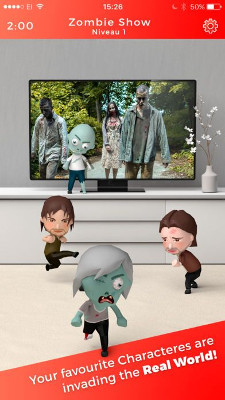‘We Are TV’ Uses AR to Evolve TV Experience
NEW YORK—TV is no longer a one screen experience. A recent study from Facebook shows that viewers are divided between their TV and—more often than not—their smartphone. Even so, the two screens are essentially separate experiences, with concentration typically on one more than the other. That’s one area where the new app “We Are TV” tries to be different—it uses augmented reality to offer users an interactive and sharable TV viewing experience.

While Twitter and Facebook have been two key sources for TV discussion in recent years, Martin Rogard, founder of “We Are TV” who was an executive at Dailymotion and has a background in video games, felt that they weren’t doing enough. “There is a lack of tools, there is a lack of possibilities,” with the popular social media sites he said in an interview with TV Technology. For Twitter, the conversation can be unorganized, featuring multiple hashtags for a single show. With Faecbook, Rogard found the conversation to be more post-show interactions rather than in the moment. He wanted his new app to help drive the TV conversation.
VIEW BY REACTION
Developing this new platform during a boom in augmented reality development led to one of the key parts of “We Are TV.” Using AR technology, the app allows its users to play a game where they catch computer-animated characters that relate to live programming; for instance, if someone is watching Netflix’s “Orange Is the New Black,” the AR characters will appear in orange prison jumpsuits. Users also have the ability to react to what they are watching by throwing AR tomatoes, hearts or bombs when something happens and soon, according to Rogard, share those reactions on Twitter and Facebook.
“We realized that augmented reality was bringing something very strong to the party and to the possibility to create enough to drive conversation around TV,” said Rogard. “The fact that with augmented reality you are watching the show, you are about to do something with the show in the background, which is something you cannot do if you’re just using a classic old second screen application.”
The choice of playing either the game or simply reacting to things happening on screen with tomatoes, hearts, etc., is up to the users. To launch the game, there is a trigger button that pops up when using the app. Once played, the trigger won’t pop up again for 10 minutes.
TWEAKING ALGORITHMS
Get the TV Tech Newsletter
The professional video industry's #1 source for news, trends and product and tech information. Sign up below.
A slate of new features are currently in development, including the ability to record what happens in the app and share it on social media, which Rogard says should be available in the coming weeks. Also, the app currently can send alerts to users notifying them when a show they have previously watched will be playing live, but there’s work to develop the ability to take what users have watched in the past and recommend new shows based on their interests through the app.

Beyond just the app’s basic functions, Rogard wants to create more direct relationships with programming and networks to further customize the types of games that “We Are TV” offers, “depending on the sport you’re watching, on the specific kind of show you’re watching,” said Rogard. Though the app has AR characters that are based on shows like “Orange is the New Black,” “Game of Thrones” and “The Walking Dead,” there is no current relationship between the app and any U.S.-based show and Rogard said the characters are designed to be reminscient, but different enough to avoid licensing issues.
“We Are TV” runs on iOS (iOS 9 and above) and Android devices.
“We Are TV” launched in France on Oct. 7. Rogard says that it has a partnership with a French television show (“Anything Goes”), which was part of the reason to focus its initial push there. The app is available in the U.S., but “We Are TV” is not currently devoting much marketing to it growing its U.S. base. Rogard puts the current number of “We Are TV” users at more than 120,000, with 85 percent of those users in France. A more strategic push in the U.S. is expected in 2018 and beyond. “We want to launch in additional countries pretty fast,” said Rogard. “The plan long term is to be everywhere.”
